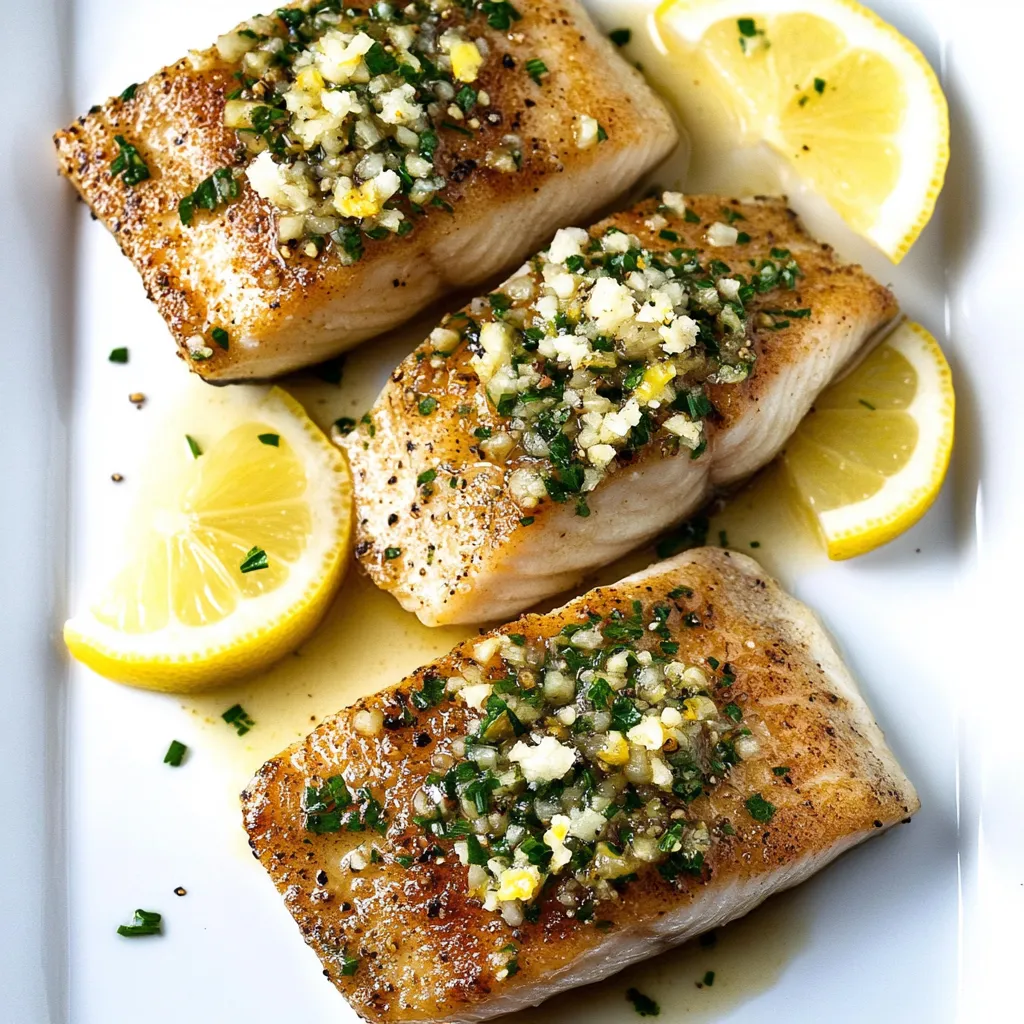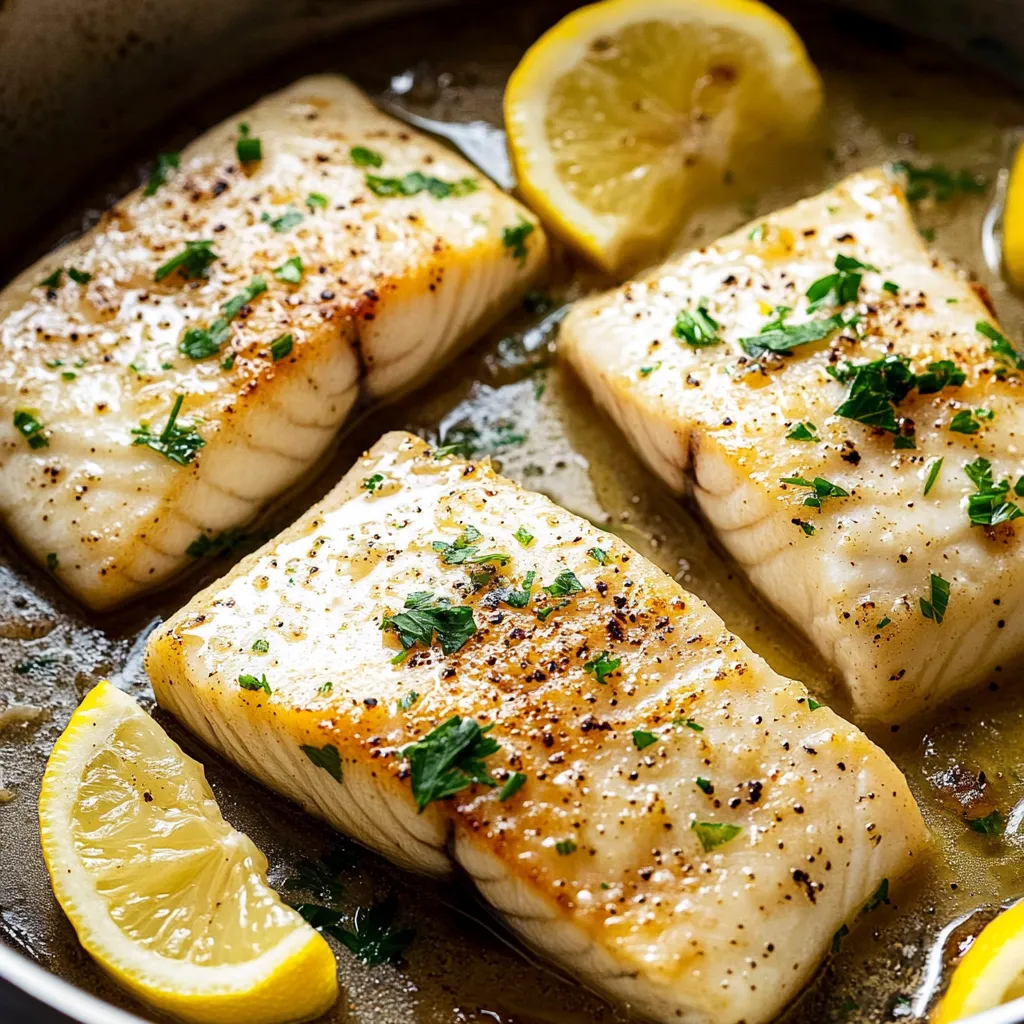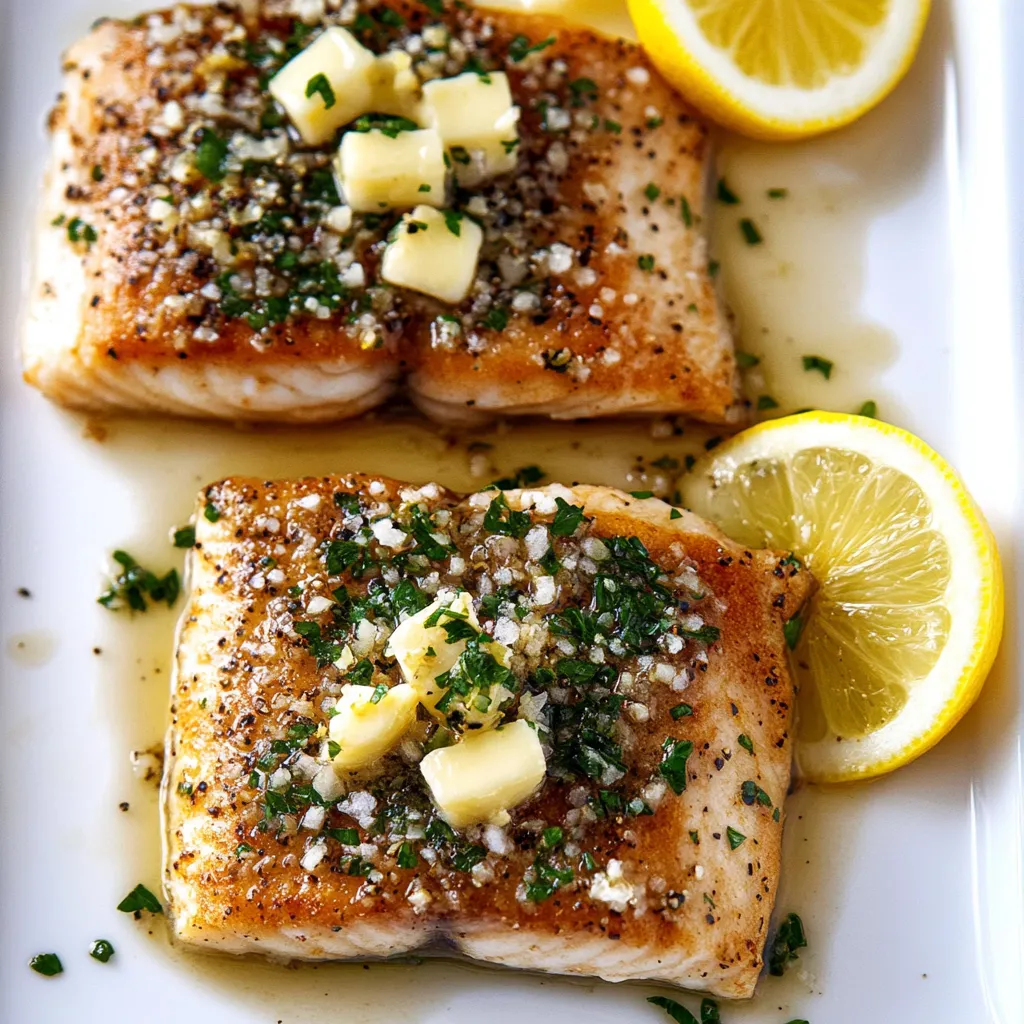 Pin it
Pin it
Searing mahi mahi on the stovetop then finishing it in the oven creates fish with a golden crust outside and tender, flaky center inside. The lemon garlic butter sauce drizzled over top adds restaurant-quality flavor without complicated techniques or hard-to-find ingredients. This mild, firm fish appeals even to people who claim they don't like seafood, and the whole process from start to plated dinner takes maybe fifteen minutes. Getting the timing right means perfectly cooked fish that's moist and flavorful instead of dry and rubbery.
Fish cooking became less intimidating after I learned the stovetop-to-oven technique that takes guesswork out of timing. My early attempts at cooking fish on the stovetop alone resulted in burnt outsides with raw centers or overcooked rubber. Searing first to develop color, then finishing in a hot oven cooks everything evenly without needing constant attention. Mahi mahi specifically works beautifully because its firm texture holds together during cooking instead of falling apart like more delicate fish. The lemon garlic butter sauce started as a simple pan sauce but has become my signature preparation that guests always request.
Ingredients and Why They Matter
- Mahi mahi fillets (4 pieces, 4 ounces each, 1-inch thick): Firm, mild fish that stays moist; frozen works if thoroughly thawed and dried
- Olive oil (3-4 tablespoons): Prevents sticking and helps browning; high smoke point oils like avocado or canola substitute
- Salt and black pepper (to taste): Essential for seasoning the fish properly
- Optional paprika (light sprinkle): Adds color and subtle flavor
- Salted butter (4 tablespoons, ½ stick): Creates rich, silky sauce; unsalted works but adjust salt
- Fresh garlic (4-5 cloves, minced): Aromatic punch that defines this sauce; don't use jarred garlic
- Fresh lemon juice (1 tablespoon plus more to taste): Bright acidity that cuts through butter richness
- Lemon zest (from 1 lemon): Concentrated citrus oils intensify lemon flavor
- Fresh parsley (2 tablespoons chopped): Adds color and fresh herbal notes; basil or chives substitute
How To Make It
- Prepare the lemon butter sauce:
- Start by making your sauce so it's ready when the fish finishes cooking. In a small saucepan over low heat, melt the butter completely. Add the minced garlic and cook gently, stirring constantly, for about 1-2 minutes until fragrant but not browned - burnt garlic tastes bitter. Remove from heat and stir in the lemon juice, lemon zest, and a pinch of salt. Taste and adjust seasoning. Keep the sauce warm over the lowest heat setting or set it aside to rewarm later. The sauce can be made hours ahead, refrigerated, and gently reheated before serving. Having it ready means you can immediately drizzle it over the fish the moment it comes out of the oven.
- Preheat oven and prepare fish:
- Turn your oven to 400°F and let it preheat completely - this is crucial because you'll be transferring the fish directly from stovetop to oven. Remove the mahi mahi fillets from any packaging and place them on a plate. Use several paper towels to pat the fish completely dry on all sides, pressing firmly to absorb all surface moisture. This step is non-negotiable because wet fish steams instead of browning, and you want that beautiful golden crust. Check that all your fillets are approximately the same thickness - around 1 inch - so they cook evenly. Season both sides generously with salt and black pepper. If using paprika, sprinkle a light dusting on top.
- Heat the oil properly:
- Place a large oven-safe skillet - cast iron or stainless steel work perfectly - over medium-high heat. Add 3-4 tablespoons of olive oil, enough to coat the bottom of the pan generously. Let the oil heat for 2-3 minutes until it shimmers and is almost smoking. You want the oil very hot before adding fish. Test by flicking a drop of water into the pan - it should sizzle and evaporate immediately. This high heat is essential for creating that golden crust quickly without overcooking the interior. Don't use a nonstick pan because it can't handle the high heat and won't brown fish as well.
- Sear the fish:
- Carefully place the seasoned fish fillets into the hot oil, laying them away from you to avoid splatters. Don't crowd the pan - cook in batches if needed to leave space between fillets. Once the fish hits the pan, resist any urge to move it around. Let it sit completely undisturbed for exactly 3 minutes. This stationary time allows proper browning and crust formation. Moving the fish prevents browning and causes sticking. The fish will release from the pan naturally once properly seared. After 3 minutes, use a thin metal spatula to carefully flip each fillet. The cooked side should be golden brown with crispy edges.
- Finish in the oven:
- Immediately after flipping, transfer the entire skillet directly into your preheated 400°F oven. Don't wait - the timing is important. Roast for about 5 minutes, checking at 4 minutes if your fillets are on the thinner side. The fish is done when the top is golden, the flesh is opaque throughout, and it flakes easily when tested with a fork. The internal temperature should read 145°F on an instant-read thermometer inserted into the thickest part. Mahi mahi cooks quickly, so watch carefully to avoid overcooking which makes it dry and rubbery. When done properly, the fish will be moist, tender, and flaky.
- Sauce and serve:
- Carefully remove the hot skillet from the oven using oven mitts - the handle will be dangerously hot even if it doesn't look it. Transfer the fish fillets to serving plates using a spatula. Rewarm the lemon butter sauce briefly if it cooled, stirring to recombine. Spoon the warm sauce generously over each fillet, making sure to get some of that minced garlic on each piece. Garnish with freshly chopped parsley and additional lemon wedges on the side. Serve immediately while the fish is hot and the butter sauce is liquid and glossy. The combination of crispy exterior, tender fish, and bright lemony butter creates exactly what you want in restaurant-quality seafood.
 Pin it
Pin it
Mahi mahi became my preferred fish after years of cooking salmon and getting complaints about fishy taste. Some family members won't eat strongly flavored fish, but mahi mahi's mild flavor converted them into seafood eaters. The firm texture also makes it easier to handle than delicate fish like sole or flounder that fall apart if you look at them wrong. My kids who claimed to hate fish will eat mahi mahi without complaint, especially with that buttery lemon sauce masking any remaining fishy notes. Now I keep frozen mahi mahi fillets in the freezer for quick weeknight dinners.
Choosing Quality Mahi Mahi
Fresh mahi mahi should smell clean and slightly sweet, never fishy or ammonia-like. The flesh should be firm and spring back when pressed, not mushy or soft. Color ranges from pinkish to beige depending on whether it's from warmer or cooler waters. Avoid fillets with brown spots or dried edges. **Flash-frozen** mahi mahi often tastes better than "fresh" fish that's been sitting for days because it's frozen immediately after catching, preserving quality. Wild-caught generally has better flavor and texture than farmed. When buying frozen, choose vacuum-sealed packages without ice crystals, which indicate thawing and refreezing. Thaw frozen fish in the refrigerator for 24 hours, never at room temperature.
The Stovetop-to-Oven Method
This two-stage cooking technique solves the common problem of overcooked exteriors with raw centers. **Stovetop searing** develops flavorful crust quickly through direct contact with hot metal. **Oven finishing** provides gentle, even heat that cooks the interior without burning the outside. The method works because you're using two different heat sources for different purposes - intense direct heat for browning, gentle ambient heat for cooking through. This approach particularly benefits thick proteins that need time to cook internally. Thin fish fillets don't need this method - they cook through during stovetop searing alone.
Oil Temperature Importance
Proper oil temperature determines whether fish browns beautifully or sticks miserably. Too-cool oil causes fish to absorb grease and stick to the pan. Hot oil creates immediate sear that forms crust preventing sticking. The proteins on the fish surface denature and release naturally from the pan once properly seared. Pulling fish too early, before it releases, tears the flesh. Visual cues for hot oil include shimmer, slight smoke, and the drop-of-water test. Different oils have different smoke points - refined olive oil handles higher heat than extra virgin, while avocado oil goes even higher. Match your oil choice to your heat needs.
Doneness Indicators
Knowing when fish is perfectly cooked prevents both undercooking and overcooking. Visual cues include opaque flesh instead of translucent, **flaking when tested with a fork**, and slight separation of the flakes. An instant-read thermometer reading **145°F** at the thickest part indicates safe doneness. The fish will continue cooking slightly from residual heat after removing from the oven, so pulling it at 140-143°F prevents overcooking. Overcooked mahi mahi becomes dry, tough, and stringy. Undercooked fish is translucent and rubbery. Perfect fish is opaque, moist, and flakes into tender pieces. With practice, you'll recognize doneness by appearance and touch without needing a thermometer.
Sauce Variations
While lemon garlic butter is classic, simple variations create different flavor profiles using the same base technique. Add capers and white wine for **piccata-style sauce**. Stir in Dijon mustard and fresh dill for **creamy mustard sauce**. Use lime juice instead of lemon and add cilantro for **Latin-inspired sauce**. Mix in sun-dried tomatoes and basil for Mediterranean flavors. Add a pinch of red pepper flakes for **spicy lemon butter**. Substitute browned butter for regular butter for nutty depth. Each variation takes seconds but transforms the dish while keeping the fish preparation identical.
Alternative Fish Options
The recipe works beautifully with other firm white fish that have similar thickness and texture. **Halibut** stays moist and has mild, sweet flavor. **Cod** has slightly softer texture but wonderful flavor. **Swordfish** is meatier and more substantial. **Grouper** offers delicate sweetness. **Sea bass** provides buttery richness. **Red snapper** has mild, slightly sweet taste. Each fish requires the same cooking method and timing for 1-inch fillets. Avoid delicate fish like tilapia, sole, or flounder which fall apart too easily for this technique. Match your fish choice to what's freshest and best quality at your market.
Serving Suggestions
Mahi mahi pairs well with light sides that don't overpower its delicate flavor. Serve over **rice pilaf**, jasmine rice, or wild rice to catch that buttery sauce. Roasted vegetables like **asparagus**, green beans, or Brussels sprouts add color and nutrition. A fresh green salad with vinaigrette provides crisp contrast. Garlic roasted potatoes create heartier meal. Orzo or couscous salad with lemon adds Mediterranean flair. Steamed spinach keeps things simple and healthy. The fish is rich enough that sides can stay simple - crusty bread and salad make a complete meal.
 Pin it
Pin it
This mahi mahi recipe represents exactly the kind of cooking that makes weeknight dinners feel special without requiring hours of work or advanced skills. The combination of crispy seared exterior, tender flaky center, and bright lemony sauce creates restaurant-quality results from straightforward techniques. When you serve this and people ask what restaurant it came from, telling them you made it yourself feels satisfying. Sometimes the best recipes are the ones that look and taste impressive while being secretly simple, and this mahi mahi definitely accomplishes that goal perfectly every single time you make it.
Frequently Asked Questions
- → How do I know when mahi mahi is done cooking?
- The fish is ready when it flakes easily with a fork and the center is opaque. It should reach an internal temperature of 145°F. Be careful not to overcook it or it will dry out.
- → Can I use frozen mahi mahi for this recipe?
- Yes, but make sure to thaw it completely first. Pat it very dry with paper towels before cooking to get a good sear on the outside.
- → What can I serve with mahi mahi?
- This fish pairs well with rice, roasted vegetables, a fresh salad, or steamed asparagus. Mashed potatoes or quinoa also work great as sides.
- → Do I need an oven-safe pan for this recipe?
- Yes, you need a pan that can go from stovetop to oven. Cast iron or stainless steel pans with metal handles work best. Avoid pans with plastic handles.
- → Can I make the lemon butter sauce ahead of time?
- Absolutely! Mix all the sauce ingredients together and store in the fridge. Just reheat it gently on the stove right before serving over your cooked fish.
- → What if I don't have fresh lemon?
- Fresh lemon really makes a difference in this recipe, but in a pinch you can use bottled lemon juice. You'll need about the same amount called for in the recipe.
- → How thick should the mahi mahi fillets be?
- Aim for fillets that are about 1 inch thick. This thickness cooks perfectly with the sear-then-bake method and stays moist in the center.
